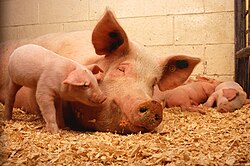This is an old revision of this page, as edited by 83.250.234.164 (talk) at 21:59, 18 June 2006 (→Breeds outside the UK). The present address (URL) is a permanent link to this revision, which may differ significantly from the current revision.
Revision as of 21:59, 18 June 2006 by 83.250.234.164 (talk) (→Breeds outside the UK)(diff) ← Previous revision | Latest revision (diff) | Newer revision → (diff)
| Domestic Pig | |
|---|---|

| |
| Sow and five piglets | |
| Conservation status | |
 Least Concern | |
| Scientific classification | |
| Kingdom: | Animalia |
| Phylum: | Chordata |
| Class: | Mammalia |
| Order: | Artiodactyla |
| Family: | Suidae |
| Genus: | Sus |
| Species: | S. scrofa |
| Binomial name | |
| Sus scrofa Linnaeus, 1758 | |
| Synonyms | |
|
Sus domesticus | |
The domestic pig (Sus scrofa domesticus) is usually given the scientific name Sus scrofa, though some authors call it S. domesticus, reserving S. scrofa for the wild boar. It was domesticated approximately 5,000 to 7,000 years ago. Pigs are found across Europe, the Middle East and extend into Asia as far as Indonesia and Japan. The distinction between wild and domestic animals is slight, and domestic pigs have become feral in many parts of the world (for example, New Zealand) and caused substantial environmental damage.
Sus scrofa has four subspecies, each occupying distinct geographical areas:
- Sus scrofa scrofa (western Africa, Europe)
- Sus scrofa ussuricus (northern Asia and Japan)
- Sus scrofa cristatus (Asia Minor, India)
- Sus scrofa vittatus (Indonesia)
Pigs were brought to southeastern North America from Europe by De Soto and other early Spanish explorers. Escaped pigs became feral and were freely used by Native Americans as food.
As food
The primary use of the domestic pig is as a meat animal. The meat from a pig is called pork.
Popular food products made of pork include sausage, bacon, ham, pig knuckles, etc. The head of a pig can be used to make head cheese. Liver, chitterlings, and other offal from pigs are also widely used for food, although their consumption is less common in certain countries, including United States.
In certain religions, especially Judaism and Islam, there are religious restrictions on the consumption of pork.

In industrialized nations, domestic pigs are often raised in large-scale intensive farming where the meat can be mass-produced. Many countries have introduced laws to regulate treatment of farmed animals. For example the USA National Pork Board produced a document called Take Care
The air which factory farmed pigs breathe may be polluted with dander, dust and fumes from pigs’ urine and faeces if the sheds are not properly ventilated. Many suffer respiratory disease. Salmonella and gastroenteritis infections are also endemic in overcrowded piggeries.
Sows (female pigs) may produce over twenty piglets per year in two litters. 15% of piglets die within two or three weeks of birth. The major contributor to this (both indoors and outdoors) is being crushed by their mother, so a farrowing pen is designed to provide a space for the piglets that the mother cannot lie on .
Piglets can be subjected to a range of treatments including castration, tail docking to reduce tail biting, teeth clipped (to reduce injuring their mother's nipples) and their ears notched to assist identification.
Piglets may be weaned and removed from their mothers between two and five weeks old and placed in sheds.
Many of the pork products purchased in supermarkets and restaurants in industrial countries come from these types of farms.

In developing nations and rural areas of developed nations, the domestic pig is frequently raised outdoors in yards. In some cases pigs are even raised in open fields where they are allowed to forage; they are watched by swineherds, essentially shepherds for pigs. It is claimed that the meat is more tender and tasteful, and if space is not an issue, economics of farming better with relaxed, happy and healthy animals.
In the USA, the federal Humane Slaughter Act requires pigs to be stunned before slaughter, however there is sometimes insufficient compliance or enforcement.
As pets
Pigs are known to be intelligent animals and have been found to be more trainable than dogs or cats. Asian pot-bellied pigs, a smaller subspecies of the domestic pig, have made popular house pets in the United States beginning in the latter half of the 20th century. Regular domestic farmyard pigs have also been known to be kept indoors, but due to their large size and destructive tendencies, they typically need to be moved into an outdoor pen as they grow older.
Breeds of pigs

Breeds within the UK
In the UK, pig breeds are generally classified into two groups:
- Traditional
- Berkshire
- Hampshire
- Large Black
- Large White
- Middle White
- Tamworth Pigs
- Wessex Saddleback
- Chester White
- Gloucestershire Old Spots
- Oxford Sandy and Black
- British Lop
- Welsh
- Modern
- Duroc
- Landrace
Breeds outside the UK
Pig breeds outside the UK include:
- Zungo
- Yanan
- West French White
- Vietnamese Potbelly
- Spotted
- Red Wattle
- Norwegian Yorkshire
- Kune-Kune (pronounced "koonee-koonee")
- Piétrain
- Tokyo-X
See also
References
- Template:IUCN2006
- The Humane Society of the United States
- Facatory Farming Photo Gallery
- Factory Pork Production